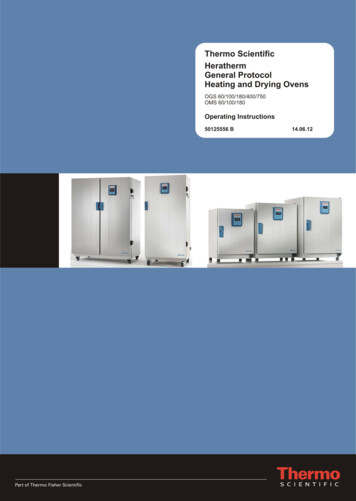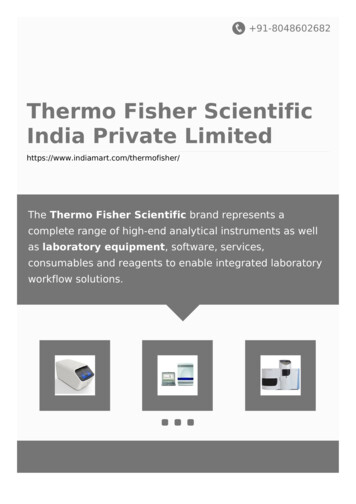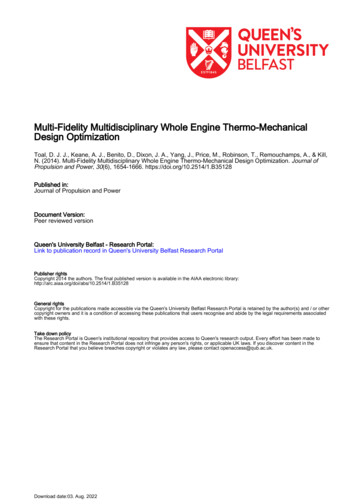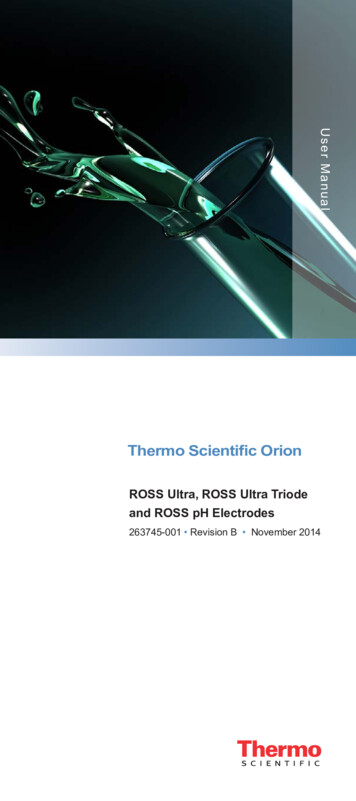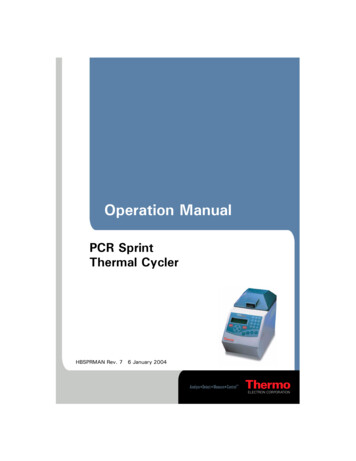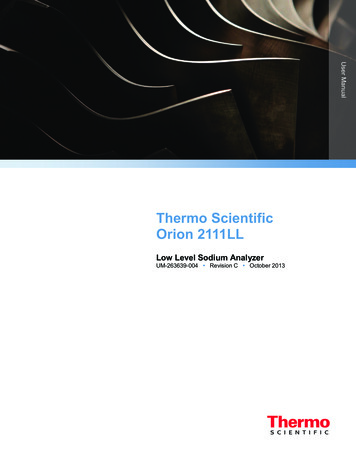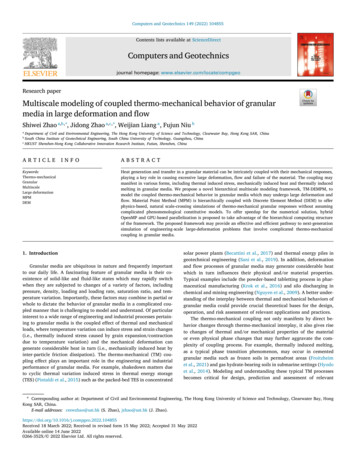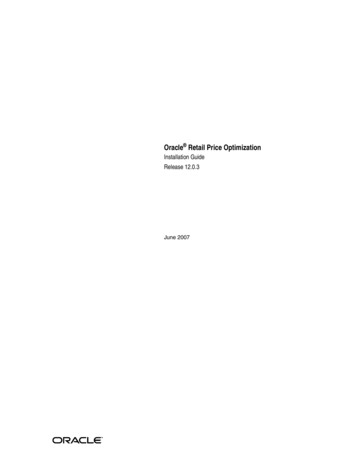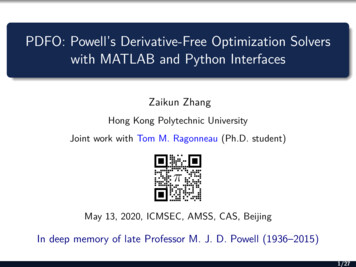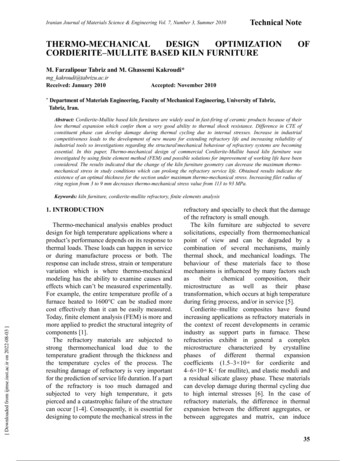
Transcription
Iranian Journal of Materials Science & Engineering Vol. 7, Number 3, Summer 2010Technical ��MULLITE BASED KILN FURNITUREOFM. Farzalipour Tabriz and M. Ghassemi Kakroudi*mg kakroudi@tabrizu.ac.irReceived: January 2010*Accepted: November 2010Department of Materials Engineering, Faculty of Mechanical Engineering, University of Tabriz,Tabriz, Iran.Abstract: Cordierite-Mullite based kiln furnitures are widely used in fast-firing of ceramic products because of theirlow thermal expansion which confer them a very good ability to thermal shock resistance. Difference in CTE ofconstituent phase can develop damage during thermal cycling due to internal stresses. Increase in industrialcompetitiveness leads to the development of new means for extending refractory life and increasing reliability ofindustrial tools so investigations regarding the structural\mechanical behaviour of refractory systems are becomingessential. In this paper, Thermo-mechanical design of commercial Cordierite-Mullite based kiln furniture wasinvestigated by using finite element method (FEM) and possible solutions for improvement of working life have beenconsidered. The results indicated that the change of the kiln furniture geometry can decrease the maximum thermomechanical stress in study conditions which can prolong the refractory service life. Obtained results indicate theexistence of an optimal thickness for the section under maximum thermo-mechanical stress. Increasing filet radius ofring region from 3 to 9 mm decreases thermo-mechanical stress value from 113 to 93 MPa.Keywords: kiln furniture, cordierite-mullite refractory, finite elements analysis[ Downloaded from ijmse.iust.ac.ir on 2022-08-03 ]1. INTRODUCTIONThermo-mechanical analysis enables productdesign for high temperature applications where aproduct’s performance depends on its response tothermal loads. These loads can happen in serviceor during manufacture process or both. Theresponse can include stress, strain or temperaturevariation which is where thermo-mechanicalmodeling has the ability to examine causes andeffects which can’t be measured experimentally.For example, the entire temperature profile of afurnace heated to 1600 C can be studied morecost effectively than it can be easily measured.Today, finite element analysis (FEM) is more andmore applied to predict the structural integrity ofcomponents [1].The refractory materials are subjected tostrong thermomechanical load due to thetemperature gradient through the thickness andthe temperature cycles of the process. Theresulting damage of refractory is very importantfor the prediction of service life duration. If a partof the refractory is too much damaged andsubjected to very high temperature, it getspierced and a catastrophic failure of the structurecan occur [1-4]. Consequently, it is essential fordesigning to compute the mechanical stress in therefractory and specially to check that the damageof the refractory is small enough.The kiln furniture are subjected to severesolicitations, especially from thermomechanicalpoint of view and can be degraded by acombination of several mechanisms, mainlythermal shock, and mechanical loadings. Thebehaviour of these materials face to thosemechanisms is influenced by many factors suchastheirchemicalcomposition,theirmicrostructure as well as their phasetransformation, which occurs at high temperatureduring firing process, and/or in service [5].Cordierite–mullite composites have foundincreasing applications as refractory materials inthe context of recent developments in ceramicindustry as support parts in furnace. Theserefractories exhibit in general a complexmicrostructure characterized by crystallinephases of different thermal expansioncoefficients (1.5–3 10-6 for cordierite and4–6 10-6 K-1 for mullite), and elastic moduli anda residual silicate glassy phase. These materialscan develop damage during thermal cycling dueto high internal stresses [6]. In the case ofrefractory materials, the difference in thermalexpansion between the different aggregates, orbetween aggregates and matrix, can induce35
M. Farzalipour Tabriz and M. Ghassemi Kakroudi[ Downloaded from ijmse.iust.ac.ir on 2022-08-03 ]extensive microcracking network during coolingfrom firing temperature or/and during thermalcycling in using conditions [7-10].The thermomechanical constrains may lead tofrequent failures due to degradation of theserefractories, through cracking, spalling ofmaterials, by creep rapture.Because of increasing competitiveness inindustry, different means of extending refractorylife and increasing reliability of industrial toolsare being pursued and investigations regardingthe structural\mechanical behaviour of refractorysystems are becoming essential.Up to now, the design of refractory kilnfurniture has been conducted in conventionalways. This approach has permitted considerableprogress; however, it considerably increases thetime and cost due to the on trial-and-error methodused.In a design process steps to prevent substantialfailure and damage of a refractory under thermalload my involve [1, 11]: selectionofcompatiblerefractorymaterials; rational thermomechanical analysis anddesign toward developing acceptable stressdistributing; determination of optimal operatingcondition (specially heating scheme)During the operating cycles, kiln furnitureundergo complex mechanical and ions combined with the developedsteep temperature gradients, enforce failureswhich reduce the reliability standards andsubstantially increase the manufacturing ormaintenance costs.The objective of this paper is to provide anunderstanding of the thermo-mechanicalbehaviour of refractory kiln furniture.2. MATERIALS AND EXPERIMENTALPROCEDURES2.1. Material and Sample PreparationA commercial cordierite-mullite refractorysupplied by SRPM (Sagar and refractory parts36Fig. 1. Micrograph of cordierite mullite refractory.manufacturing) Company, Iran, is consideredhere. This refractory made of andalusiteaggregates, talc and clay that fired at 1350 C.This material is presented here can be roughlyconsidered as a composite made of mullite andresidual andalusite grains in a cordierite andamorphous matrix (Fig.1). Table 1 shows thechemical compositions and some physicalproperties of the cordierite-mullite refractorysupplied by the manufacturer.This refractory is classically used as kilnfurniture for porcelain manufacturing. With avery low coefficient of thermal expansion, it hasan excellent thermal shock resistance.The industrial investigation highlighted thatthe phase composition of the refractory containedTable 1. Chemical analysis and physical properties of thecordierite mullite refractory.Al2O3 (wt%)48-52SiO2 (wt%)40-45MgO (wt%)4Fe2O3 (wt%)1.2Porosity (%)19-22Density (kg/cm3)2.2-2.3MOR (MPa)15-20,ҏҏ (10-6 K-1)3-3.5
Iranian Journal of Materials Science & Engineering Vol. 7, Number 3, Summer 2010Table 2. Thermal and elastic properties of each component of the composite refractory.Densitygr/cm3Thermal expansioncoefficient (10-6 K-1)Young’smodulus (Gpa)Cordierite2.651.4 – 2.6132Mullite3.054.5 – 5.3220Andalusite3.15814535% mullite, 39% cordierite and 26% nonmullitised andalusite that leading to a significantthermal expansion mismatch between differentphases (Table 2).Difference of thermal expansion between theconstituents of refractory materials can lead,during heating and cooling stages, to thedevelopment of a large microcracks networkwithin the microstructure, which strongly affectsthe thermomechanical properties.[ Downloaded from ijmse.iust.ac.ir on 2022-08-03 ]2.2 Engineering Analysis Using FEM (FiniteElement Method)The pressure towards increased efficiency andreduction of the development and manufacturingcosts and time has always pushed engineers todevelop better and faster design methods forreliable products [8]. Among generalcomputational techniques, which have beendeveloped to treat thermo-mechanical problems,it must be acknowledged that the finite elementmethod (FEM) has hitherto been the mostsuccessful. This method has been usedsuccessfully for studying thermo-mechanicalbehavior of refractories in various conditions [9,10, 12-15].The object of a simulation is to provide insightinto the design of refractory materials to betterresist the stress environments in refractorycomponents under various operating conditions.Information is also provided on the mechanismsof the origin of the stress states and how theyrelate to the component fracture. An accuratethermomechanical analysis method, on which arational design approach for the refractory can bebased, is complicated by many factors. Thesefactors include: loading conditions, materialmodelling, behavioural knowledge for therefractory, complex non-linear mechanics,numerical analysis, etc [14]. Controlling thestresses requires the formulation of an optimumcombination of structure and properties, enablingthe system to fulfil its function whilstdeteriorating at the slowest possible rate. Itsstructure is defined by the shape and the size ofthe refractory.The finite element method (FEM) is anecessary tool for conducting a reliable refractoryinvestigation. A refractory investigation isusually conducted in two steps: The first is an evaluation of the thermalresponse of the system, which may be bothsteady-state and transient;Fig. 2. Geometry of the refractory models.37
M. Farzalipour Tabriz and M. Ghassemi Kakroudi Fig. 3. Typical cracking scheme in refractories. The second step of the analysis consists inevaluating the thermal stresses within thesystem.[ Downloaded from ijmse.iust.ac.ir on 2022-08-03 ]Figure 2 illustrates the schematic sketch of kilnfurniture. Improper design of kiln furniture canintensify the damages resulted from themicrostructure origins by imposing excess stresswhich results in early failure of refractories as itcan be seen in figure 3.Therefore, by modifying the kiln furnituredesign for decreasing maximum stress which isthe place of crack nucleation, we can improve theworking life of them. Some of the effectivesolutions are listed below: increase of kiln furniture height to avoidsuperposition of mechanical and thermalstresses increase of leg thickness to decreasemechanical stress valueincrease of A radius to increase thethickness of ring regionIt is obvious that by increasing the thickness ofsection under load, mechanical stress willdecrease but it will result in increase of kilnfurniture weight and the force exerted to therefractories in bottom of columns. Also due tolow thermal conductivity it will increase thetemperature gradient in refractories and increasethe thermal stress. By considering that the heightof kilns are fixed so increase in height of the kilnfurniture will result in decrease of the number ofthem that can be loaded to the kiln in eachcolumn which is not economically favourable.In this article the third approach is mainlyconsidered. Change in A radius from 1 to 11 mm(3mm in original sample) has been investigated.In this study, commercial FEM software:ABAQUS 6.6 was used for numerical calculationof stress in models. Due to existence of cornerswith high angle, meshing of sample was doneusing C3D10MT elements that are quadratictetragonal elements with 10 nodes. The mesharound the stress concentration regions was madefiner than those in the other areas.3D meshed model of kiln furniture is shown infigure 4.Material properties were assumed to beisotropic and linearly elastic; their values areshown in Table 3.In investigated industrial kilns, 15 kilnfurniture stack up in a column, each containing aFig. 4. 3D geometry and finite element mesh of models.38
Iranian Journal of Materials Science & Engineering Vol. 7, Number 3, Summer 2010Table 3. Physical properties of the al conductivityThermal capacityCoefficient of thermal expansionYoung modulusPoisson ratiovaluekgm3W1m.KJ1100kg.K3.03 10-6/K34000 MPa0.21910porcelain body of about 500g and they are heatedto 12ºC/min up to 1380ºC and cooled 20ºC/min.3. RESULTS AND DISCUSSIONThe experimental results show that the level ofmechanical resistance of the refractory materialdepends on the shape of the sample and theboundary conditions.[ Downloaded from ijmse.iust.ac.ir on 2022-08-03 ]aMaximum mechanical stress is applied to thebottom sample in the column in workingcondition, so loading condition of this samplewas used for the whole models. Mechanical andthermo-mechanical stress distribution in originalsamples are shown in figure 5.The effects of increase refractories height andtheir legs’ thickness on stress profile of refractorysamples are shown in figure 6. Although thesechanges are not preferred but decrease of thestress values and changes in stress profiles areobvious.The variations of maximum mechanical andthermo-mechanical stress of models with variouscurve radiuses "A" are listed in table 4.The results indicate that by increasing curveradius up to 9 mm, both mechanical and thermomechanical stresses decrease, but after 9 mm, thesample weight increases so increase of thicknesssection overcome control the stress values. Sothere is an optimum radius value for the samplesbFig. 5. Distribution of a) Mechanical stress and b) Thermo-mechanical stress in model.Fig. 6. Thermo-mechanical stress profile in models with a) longer legs and b) thicker legs.39
M. Farzalipour Tabriz and M. Ghassemi KakroudiTable 4. Variations of maximum mechanical and thermo-mechanical stress of kiln furniture by changing “A” radius.A radii(mm)1 ̋̀̂ Maximum Mechanical Stress(MPa)91.586.171.259.857.266.9Maximum Thermo-mechanical Stress(MPa)120.7113.3101.293.693.1103.5solutions was choose and its effect on maximummechanical and thermo-mechanical stress profileinvestigated. The stress analysis reveals that themaximum compressive stress occurs at inner wallof model. Obtained results indicate the existenceof an optimal thickness for the section undermaximum thermo-mechanical stress. Increasingfilet radius of ring region from 3 to 9 mmdecreases thermo-mechanical stress value from113 to 93 MPa.5. ACKNOWLEDGEMENTS[ Downloaded from ijmse.iust.ac.ir on 2022-08-03 ]Fig. 7. Schematic representation of thermal stress effect oncompressivestress of inner wall.in this working condition.Obviously there are two distinct regions insamples stress profile: The outer region expandsdue to temperature increasing and it applies thetensile stress to the colder region which is incontact with and a colder region that is expandingin interface with warmer region. For conservationof volume in cold region the opposite side of itshould be compressed that intensify thecompressive stress in inner side of the wall sothermal loading of refractories intensify the stressapplied by mechanical means (Figure 7).4. CONCLUSIONIn this paper, the failure of commercial kilnfurniture used in ceramic industry wasinvestigated and the solutions proposed toovercome this issue were investigated. Thedesired changes applied to the Finite Elementmodel and thermo-mechanical analysis was done.One of the possible and commercially preferable40Authors would like to thank the TabrizUniversity for financial support of this study andalso Iranian SRPM Company for supplying thestudied materials.REFERENCES1.2.3.4.5.6.Rathner, R., Knauder, J., Weissensteiner, H.,"Thermomechanical Behaviour of Refractory Liningwith Special Emphasis on BOF-Vessels" Proceedingof the Unified Int. Tech. Conf. on Refractories,(UNITECR’91), Aachen, Germany, 1991, 12-18Chester, J. H., Refractories: Production andProperties, Metal Society, London, 1983 pp. 65-83Kingery, W. D., Bowen, H. K., Uhlman, D. R.,Introduction to Ceramics, Second ed, WileyIntersience, New York, 1976, pp. 773-797Schmitt, N., Berthaud, Y. Poirier, J., Tensile Behaviorof Magnesia Carbon Refractories. J. Eur. Ceram.Soc., 20 (2000) 2239-2248.Serry, M. A., Telle, R., Thermomechanical propertiesof high alumina castables. J. Am. Ceram. Soc. Bull.,79 (2000) 71-75.Miyamoto, M., Onoye, T., Narita, K., Deformationand Failure of Blast Furnace Refractories with Jointsat Elevated Temperature. Interceram (Special Issue)
Iranian Journal of Materials Science & Engineering Vol. 7, Number 3, Summer 20107.8.9.10.11.12.13.14.[ Downloaded from ijmse.iust.ac.ir on 2022-08-03 ]15.32 (1983) 107-110.Bejan, A., Tsatsaronis, G., Moran, M., ThermalDesign and Optimization, Wiley-Interscience, 1995,pp. 25-42Janssens, K. G. F., Raabe, D., Kozeschink, E.,Miodownik, M.A., Nestler, B., ComputationalMaterials Engineering, Elsevier Inc., 2007, pp. 179217Andreev, K., Harmuth, H., FEM simulation ofthermomechanical behaviour and failure ofrefractories – a case study. Journal of MaterialsProcessing Technology, 143-144 (2003) 72-77.Gruber, D., Andreev, K., Harmuth, H. FEMsimulation of the thermomechanical behaviour of therefractory lining of a blast furnace. Journal ofMaterials Processing Technology, 155-156 (2004)1539-1543.Chen, E. S., Buyukozturk, O. "Evaluation of anIntegrated Design Process for Refractory Systems"Proceeding of the Unified Int. Tech. Conf. onRefractories, (UNITECR’89), Westerville, OH,(1989) pp. 1328-1339Boisse, P., Gasser, A., Poirier, J., Rousseau, J.Simulation of thermomechanical behaviour ofcomposite refractory linings, Composites: Part B, J.Am. Ceram. Soc. 32 (2001) 461-474.Suat, Y., Thermomechanical modelling for refractorylining of a steel ladle lifted by crane, j. Steel res. Int.,74 (2003) 485-490.Gasser, A., Boisse, P., Rousseau, J., Dutheillet, Y.,Thermomechanicalbehaviouranalysisandsimulation of steel/refractory composite linings. J.Com. Sci. and Tech., 61 (2001) 2095-2100.Simonin, F., Olagnon, C., Maximilien, S., Fantozzi,G., Diaz, L.A., Torrecillas, R., ThermomechanicalBehavior of High-Alumina Refractory Castableswith Synthetic Spinel Additions, J. Am. Ceram. Soc.,83 (2004) 2481 - 2490.41Powered by TCPDF (www.tcpdf.org)
essential. In this paper, Thermo-mechanical design of commercial Cordierite-Mullite based kiln furniture was investigated by using finite element method (FEM) and possible solutions for improvement of working life have been . Iranian Journal of Materials Science & Engineering Vol. 7, Number 3, Summer 2010 Technical Note [ Downloaded from .
